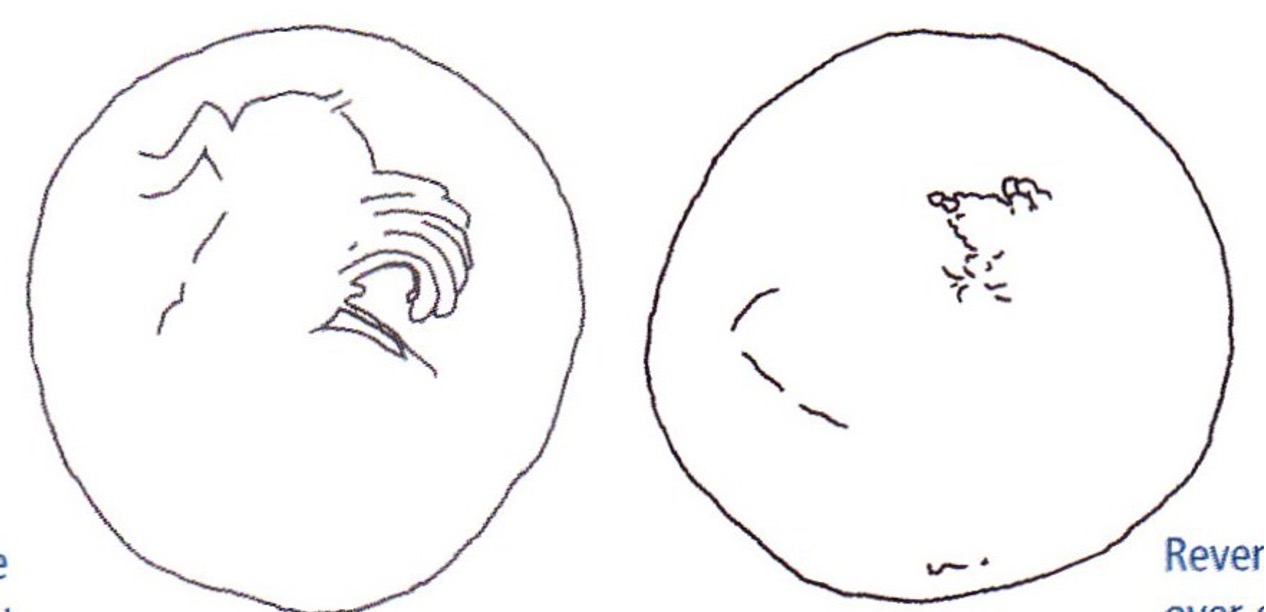365 BCE - 355 BCE | TAPAΣ
Overstriking coin
SO 1343 - Taras over Leucas.jpg
Overstruck variety
Traces of the overstruck variety
1343 Leucas (drawing).jpg
Description
| ObverseInscription or printing placed on the obverse.:
|
Horseman cantering right, arm hanging at side. Below horse, Δ.
|
ReverseInscription or printing placed on the reverse.:
|
TAPAΣ (Greek) Male character (Taras or Phalanthos), nude, seated sideways on dolphin left, holding kantharos in extended arm.
|
Mint and issuing power
| MintIdentifies the place of manufacture or issue of a numismatic object.:
|
Taras
|
Ancient regionAncient region.
|
Calabria
|
Modern countryModern country: Italy
|
AuthorityIdentifies the issuing power. The authority can be "pretended" when the name or the portrait of X is on the coin but he/she was not the issuing power. It can also be "uncertain" when there is no mention of X on the coin but he/she was the issuing power according to the historical sources:
|
|
Chronology
| FromIdentifies the initial date in a range assigned in a numismatic context. 365 BCE toIdentifies the final date in a range assigned in a numismatic context.. 355 BCE
|
Classical 480-323 BC  periodTime period of the numismatic object. periodTime period of the numismatic object.
|
Physical description
MetalThe physical material (usually metal) from which an object is made.: Silver 
|
WeightWeight of the numismatic object (in grams). in grams: 7.777.77 g <br />7,770 mg <br />
|
DenominationTerm indicating the value of a numismatic object. Examples: tetradrachm, chalkous, denarius.: nomos
|
AxisDescribes the directional relationship between the obverse and reverse of a numismatic object.: 99 mm <br />0.9 cm <br />
|
|
|
StandardStandard.: Achaian
|
References
| Coin referenceReference of the Coin:
|
MacDonald 2009, p. 12, n° 8
|
Coin series referenceReference to coin series study:
|
Ravel 19471Ravel 1947, n° 471, Fischer-Bossert 19992Fischer-Bossert 1999, group 40, n° 613 (V240/R470), MacDonald 20093MacDonald 2009, p. 12, n° 8, HN Italy4HN Italy, n° 880
|
| Coin series web referenceCoin series web references:
|
|
Description
| ObverseInscription or printing placed on the obverse.:
|
Λ (Greek) Pegasus with curled wing right (visible on bverse: reare of Pegasus, portions of rear legs, curled wing).
|
ReverseInscription or printing placed on the reverse.:
|
Head of Aphrodite right, wearing a Corinthian helmet. Behind, bunch of grapes (visible on reverse: most of grape's outline, details of back of helmet and neck, and some of throat outline).
|
Mint and issuing power
| MintIdentifies the place of manufacture or issue of a numismatic object. ᵖ:
|
Leucas
|
Ancient regionAncient region. ᵖ
|
Acarnania
|
Modern countryModern country: Greece
|
AuthorityIdentifies the authority in whose name (explicitly or implicitly) a numismatic object was issued. ᵖ:
|
|
Chronology
| FromIdentifies the initial date in a range assigned in a numismatic context. 400 BCE toIdentifies the final date in a range assigned in a numismatic context.. 375 BCE
|
Classical 480-323 BC  periodTime period of the numismatic object. periodTime period of the numismatic object.
|
Physical description
| DenominationTerm indicating the value of a numismatic object. Examples: tetradrachm, chalkous, denarius. ᵖ:
|
stater 
|
|
|
References
References
- ^ Ravel, Oscar E. (1990), Descriptive catalogue of the collection of Tarentine coins formed by M. P. Vlasto, London, Spink
- ^ Fischer-Bossert, Wolfgang (1999), Chronologie der Didrachmenprägung von Tarent, 510-280 v. Chr., Berlin, De Gruyter, xvii, 495 p., [84] pl.
- ^ Macdonald, David (2009), Overstruck Greek coins: studies in Greek chronology and monetary theory, Whitman Publishing, Atlanta.
- ^ Rutter N. Keith et alii (eds.) (2001), Historia Numorum Italy, London, xvi, 223 p., 43 pl.
- ^ Calciati, Romolo (1990), Pegasi, Mortara, Edizioni I.P..
 Traces of the overstruck variety
Traces of the overstruck variety

